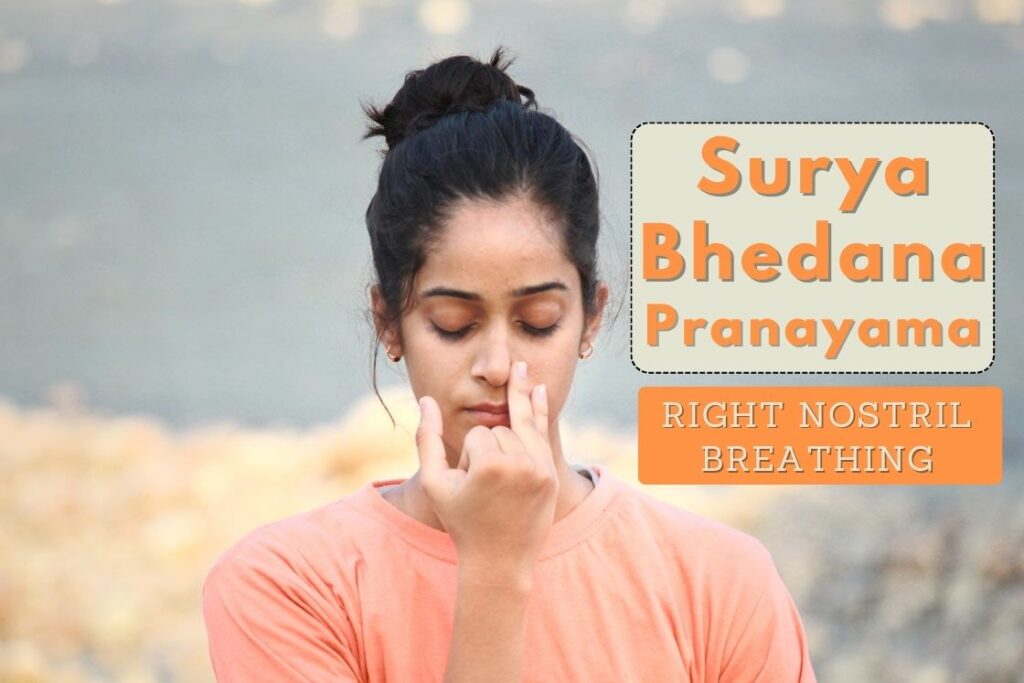
Surya Bhedana pranayama, commonly referred to as the Sun Piercing Breath, is more than just a method of breathing; it’s a gateway to enhanced vitality and mental clarity.
What exactly is Surya Bhedana Pranayama? At its core, this pranayama involves a specific pattern of breathing that focuses on energizing the body’s solar energies.
Unlike ordinary breathing, Surya Bhedana Pranayama incorporates a unique technique of inhaling and exhaling through different nostrils, each connected to specific energy channels within the body. This technique not only refines one’s control over breath but also brings about a harmonious balance in the body’s energy systems.
This guide aims to demystify surya bhedana pranayama, its benefits, technique and complete instructions to perform.
Understanding the Meaning of Surya Bhedana Pranayama
Surya Bhedana Pranayama, a term deeply rooted in the ancient language of Sanskrit, encapsulates a significant yogic breathing technique.
The name itself is a blend of three words: ‘Surya,’ ‘Bhedana,’ and ‘Pranayama.’ ‘Surya’ translates to ‘Sun,’ symbolizing vitality and energy. ‘Bhedana’ means ‘piercing’ or ‘passing through,’ and ‘Pranayama’ refers to the practice of breath control. It’s also mentioned as Surya Bhedi Pranayama in some yogic texts.
When combined, “Surya Bhedana Pranayama” essentially means a yoga breathing technique that involves the piercing or channeling of the sun’s energy through right side of the body. This pranayama practice focuses on inhaling through the right nostril, which is traditionally associated with the sun’s warming and energizing qualities.
In the context of its name, Surya Bhedana Pranayama is about activating and balancing the solar energy or Pingala nadi within the body, which is believed to enhance vitality and vigor. This aspect aligns with the yogic belief in the interconnectedness of cosmic elements and human physiology.
In English, Surya Bhedana Pranayama is often referred to as “Right Nostril Breathing” or “Sun Piercing Breath,” reflecting its focus on the right nostril and the solar energies it represents. This descriptive term makes the practice more accessible and understandable.
Surya Bhedana Pranayama in Hatha Yoga
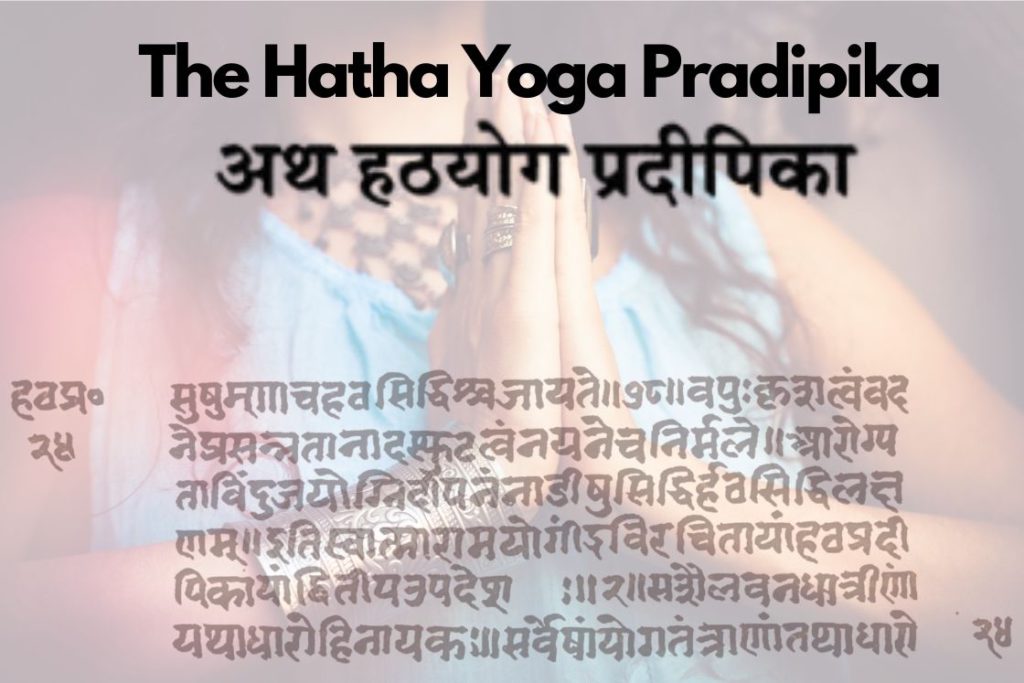
Surya Bhedana Pranayama holds a revered place in the annals of ancient yogic wisdom, particularly in texts like the Hatha Yoga Pradipika. This classical text, a cornerstone in the study of yoga, lists Surya Bhedana Pranayama as one of the eight classical pranayamas or also known as Kumbhakas, underscoring its importance in traditional practices.
The Hatha Yoga Pradipika, attributed to sage Svatmarama, delves into the profound effects of Surya Bhedana Pranayama. A specific verse (HYP verse 50) in this text illuminates the power of this practice, stating,
“This excellent Surya Bhedana destroy diseases rises from the excess of wind, purifies the brain and cures ailments caused by worms (bacteria).”
This verse not only highlights the pranayama’s therapeutic benefits but also its role in purifying and balancing the body’s energies.
The Science of Nadis in Surya Bhedana Pranayama
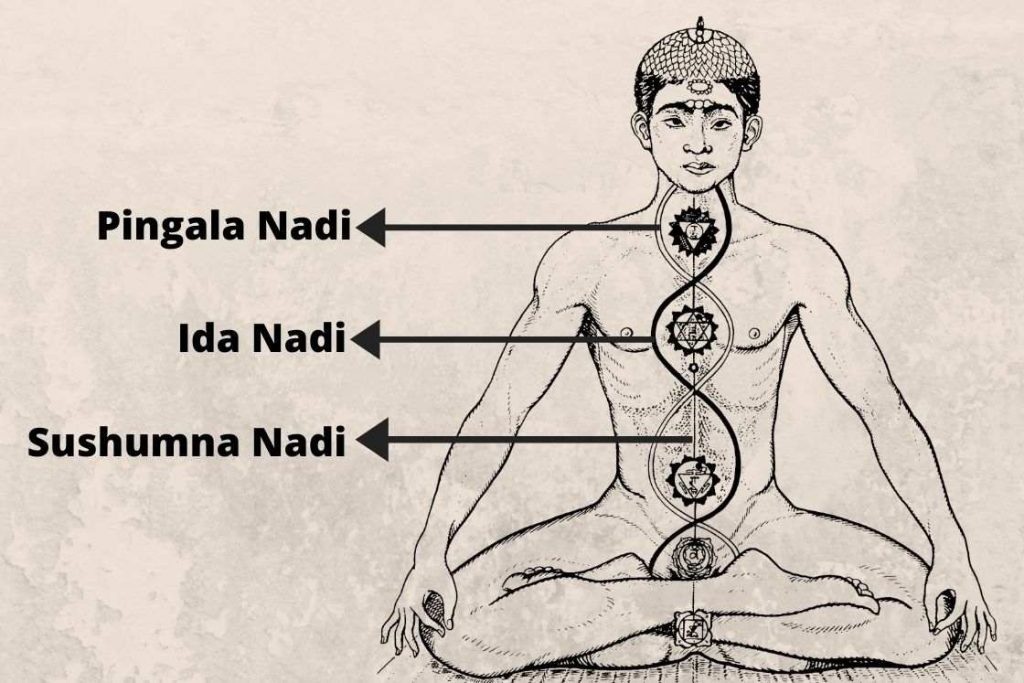
In yogic science, the concept of Nadis plays a pivotal role, especially in practices like Surya Bhedana Pranayama. Derived from Sanskrit, ‘Nadi’ signifies a channel or flow, representing the pathways through which pranic energy travels in the body. Central to this are the Pingala and Ida Nadis, each corresponding to the right and left nostrils, respectively.
Pingala Nadi, associated with the right nostril, is often referred to as the Surya (Sun) Nadi. It embodies the qualities of activity and energy (Rajas Guna), channeling the sun’s dynamic and warming attributes. On the other hand, the Ida Nadi, linked with the left nostril, is known as the Chandra (Moon) Nadi, representing relaxation and coolness.
Surya Bhedana Pranayama primarily engages the Pingala Nadi. By deliberately breathing through the right nostril, this pranayama activates the body’s sympathetic responses, thereby stimulating energy and vitality. It’s a practice that goes beyond mere breath control; it’s about harnessing and directing life force through these subtle yet powerful energy channels.
Also read: Difference between Surya Bhedana and Chandra Bhedana Pranayama
How to Perform Surya Bhedana Pranayama
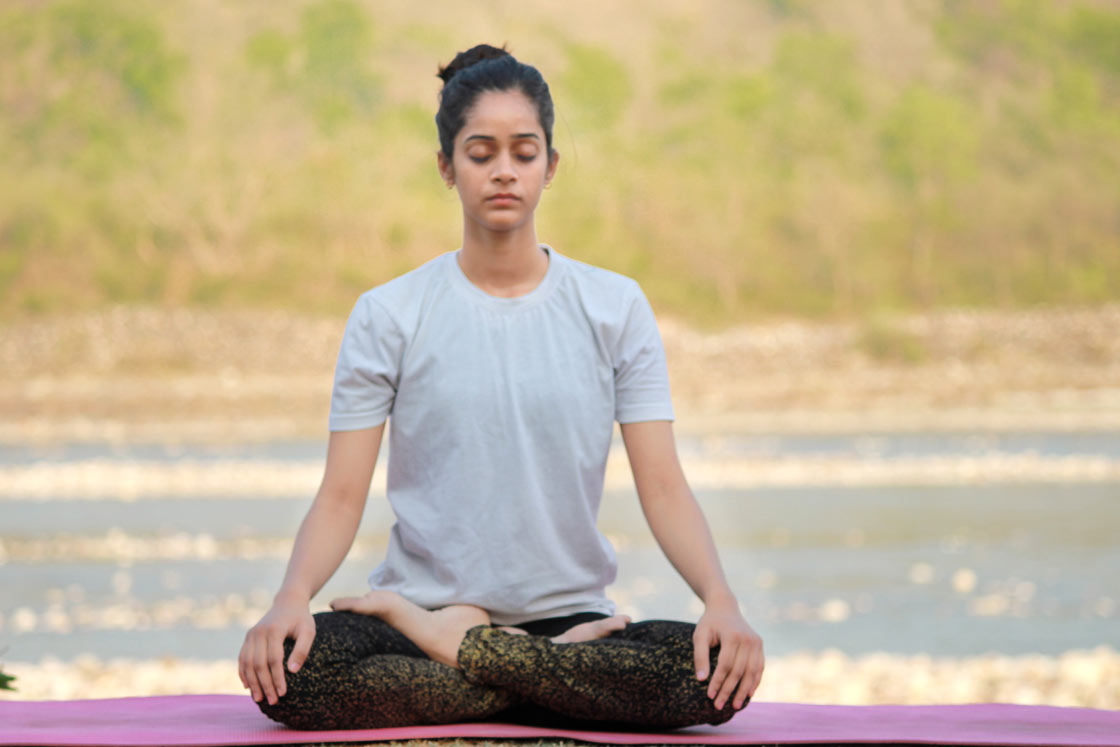
The technique: Adopt a comfortable seated posture and form Vishnu Mudra with your right hand for Surya Bhedana Pranayama. Begin by blocking the left nostril, inhaling deeply through the right. Then, close the right nostril and exhale slowly through the left. Maintain this pattern – inhale through the right, exhale through the left – for a duration of 1 to 3 minutes, ensuring smooth and controlled breaths.
Here’s detailed steps to perform it:
step 1
Preparation: Begin by finding a comfortable seated position. Easy Pose (Sukhasana) is recommended for beginners, while advanced practitioners may opt for Lotus Pose (Padmasana). Ensure your spine is erect and your body relaxed.
step 2

Adopt Vishnu Mudra with right hand: Position the mudra near your face, using your ring finger to close the left nostril. Your thumb stays close to right nostril but not blocking it. Before initiating the breathing process, ensure your lungs are fully emptied by exhaling deeply.
step 3
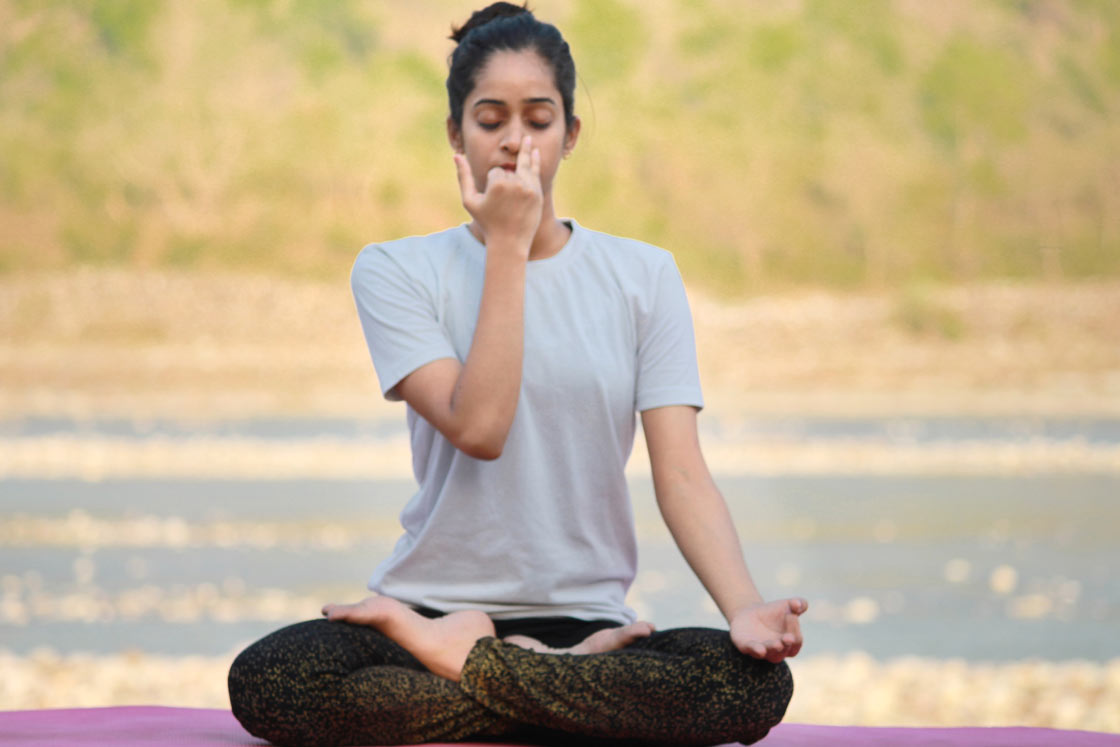
Inhale Through the Right Nostril: Use your ring finger to gently close the left nostril. Inhale deeply and smoothly through the right nostril, filling your lungs with air.
step 4

Retain the Breath: After inhaling, use your thumb to softly close the right nostril, holding the breath for a comfortable duration. Avoid strain, especially if you are new to pranayama or have health concerns.
step 5
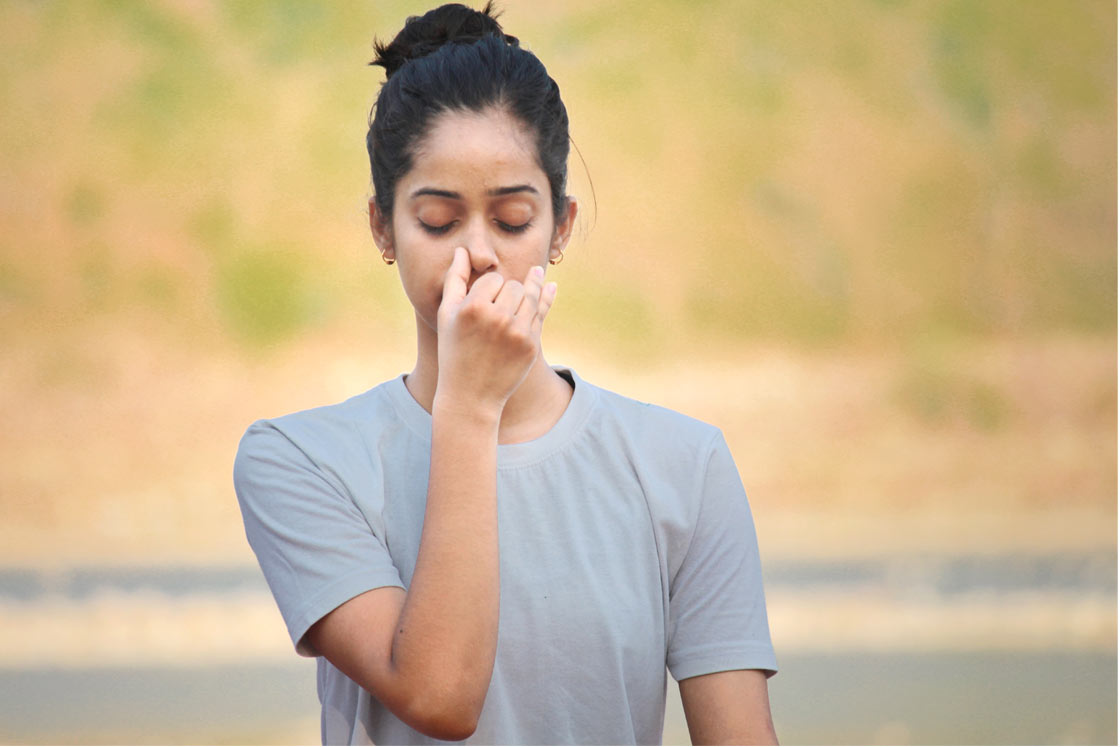
Exhale Through the Left Nostril: Release your ring finger from the left nostril and exhale slowly and completely.
As you exhale through the left nostril, notice the warmth of the air. This sensation is a testament to the internal heat generated by the Surya Bhedana Pranayama, reflecting the practice’s energizing effect on the body.
step 6
Repeat the Cycle: Continue this pattern for several rounds, following a rhythm that feels natural and comfortable to you.
Beginners may find it helpful to start surya bhedana pranayama with shorter sessions of 1 to 3 minutes or 3 to 6 rounds. Then gradually increase the duration upto 10 minutes as you become more comfortable with the technique. Remember, the essence of pranayama lies in gentle progression and attentive practice.
Breathing Technique and Ratios in Surya Bhedana Pranayama
A single cycle of Surya Bhedana Pranayama encompasses three key steps: inhaling through the right nostril (Step 3), retaining the breath (Step 4), and exhaling through the left nostril (Step 5).
To practice effectively, follow this sequence: inhale through the right nostril, hold the breath momentarily, and then exhale through the left nostril. Continue this pattern for a duration of 1-3 minutes or complete 5-10 cycles.
The breath ratio in Surya Bhedana Pranayama varies based on proficiency. Beginners may initially forego the breath retention (Step 4), maintaining a 1:1 ratio for inhalation and exhalation.
For more experienced practitioners, an advanced ratio of Inhale: Hold: Exhale is recommended at 1:4:2. This means if you inhale for one second, retain the breath for four seconds, and exhale over two seconds. This advanced ratio should be attempted only after at least 15 days of consistent practice.
Benefits of Surya Bhedana Pranayama
Surya Bhedana Pranayama is known for its energizing and warming effects. It enhances physical performance, stimulates the sympathetic nervous system, and aids in spiritual awakening. Regular practice can lead to improved cardiovascular health, better digestion, and mental clarity, making it a holistic approach to well-being.
Below we have discussed some major benefits of surya bhedana pranayama:
- Enhances Physical Performance: Practicing Surya Bhedana Pranayama stimulates the body, enhancing overall physical energy and stamina. This increased vitality is particularly beneficial for those leading active lifestyles or seeking to improve their physical fitness.
- Improves Cardiovascular Health: This pranayama technique helps maintain a healthy heart and can be an adjunct to preventing cardiovascular ailments, especially when combined with a balanced lifestyle and diet.
- Activates Sympathetic System: It leads to increased oxygen uptake and sympathetic nervous system activation, offering potential therapeutic effects on both mind and body.
- Clears Sinuses: The warming nature of surya bhedi pranayama makes it effective for clearing and purifying sinuses, especially beneficial during colder months.
- Aids Weight Loss: Regular practice can contribute to weight loss, likely due to a combination of increased metabolism and lifestyle changes.
- Balances Vata Dosha: According to Ayurveda, Surya Bhedana Pranayama balances the Vata Dosha, helping to pacify excess wind energy in the body.
- Awakens Kundalini: In Hatha and Tantra Yoga, this pranayama is used to awaken Kundalini energy, enhancing spiritual growth when combined with specific mudras and bandhas.
- Digestive Health: Surya bhedi pranayama stimulates the digestive fire (Jatharagni in Ayurveda), improving digestion and addressing issues like gas and bloating.
- Purifies Blood: This practice aids in blood purification and overall detoxification of the body.
- Mental Alertness and Clarity: Surya Bhedana Pranayama enhances focus and mental clarity, preparing the mind for meditation and higher cognitive functions.
Precautions and Contraindications
While Surya Bhedana Pranayama is generally safe, it’s important to practice it with awareness and caution:
- Avoid Overstraining: Do not retain your breath beyond comfort. Beginners should start gently and gradually increase duration.
- Health Conditions: People with cardiovascular problems, hypertension, epilepsy, or those who have undergone major surgeries should avoid this practice.
- Acid Reflux and Digestive Issues: Those suffering from acid reflux, indigestion, or diarrhea should practice cautiously.
- Avoid During Illness: Refrain from practicing if you have a fever or any acute illness.
- Not for Hot Conditions: As it generates body heat, avoid practicing in hot, humid conditions or during the summer months.
- Pregnancy Considerations: It is advised that pregnant women, particularly in the later stages of pregnancy, refrain from practicing Surya Bhedana Pranayama.
- Menstruation: Women should avoid practicing Surya Bhedana Pranayama during their menstrual cycle.
Adhering to these precautions ensures a safe and beneficial practice of Surya Bhedana Pranayama.
Conclusion
Surya Bhedana Pranayama is an enriching yogic breathing technique that embodies the ‘Ha’ energy in Hatha Yoga, symbolizing the Sun and warmth. This practice, focusing on right nostril inhalation and left nostril exhalation, harmonizes the dualities of heat and coolness, joy and melancholy.
Incorporating this pranayama into daily life nurtures breath, thought, and emotional regulation, fostering a sense of serenity, joy, and fulfillment. Consistent practice of this technique is also known to decelerate the ageing process. Given its array of benefits, integrating Surya Bhedana Pranayama into your daily regimen can significantly enhance your well-being and contribute to a balanced, healthier lifestyle.
FAQs Related to Surya Bhedana Pranayama
The ideal time to practice is in the early morning on an empty stomach. It can be practiced anytime, following pranayama guidelines, but should be avoided in summer, during the hottest part of the day, and after sunset.
It is contraindicated for individuals with epilepsy, heart disease, anxiety, and high blood pressure. It should be avoided at night to prevent difficulty in falling asleep, and consultation with a yoga instructor and physician is recommended before starting a new practice, especially for those with chronic health conditions.
Surya Bhedana is generally safe when performed correctly and with awareness of contraindications. The challenging part is retaining the breath, which should not be pushed beyond natural limits. If dizziness or fainting occurs, stop the practice and breathe normally while lying down in Corpse Pose.
The post Surya Bhedana Pranayama: Benefits, Steps to Perform and Precautions appeared first on Fitsri Yoga.